How to Grow Cordyceps Militaris.
Cordyceps Militaris is a great mushroom to grow as a amateur or professional mycologist. These mushrooms are hugely sought after because they contain a number of beneficial compounds, mainly cordycepin which has been shown to improve athletic performance.
I ran through the whole process of growing Cordyceps a multiple times before I fully understood the whole process, I did a experiments with different substrate amounts and ratios per jar before creating this guide.
If you're just getting your feet wet in the world of mycology you might be excited to find out the Cordyceps mushrooms are actually a relatively easy mushroom to grow, especially for beginners. The one drawback is Cordyceps can take 6 weeks or more to complete a full growth cycle. Alongside this growing Cordyceps comes with certain nuances that are important to keep in mind:
- Timing is Crucial: Upon receiving your Cordyceps cultures, time is of the essence. Begin your cultivation process immediately, as the cultures age rapidly and delays can affect the success of your growth cycle.
- Preparation of Liquid Culture: Before diving into the main cultivation phase, you'll need to prepare a batch of liquid culture. This step is a cornerstone for nurturing robust Cordyceps growth.
- Culture-to-Substrate Ratio: Unlike some other fungi, Cordyceps require a higher culture-to-substrate ratio because the mycelium doesn’t actually spread out like other fungi. Ensuring you have enough culture in relation to your substrate is key to promoting healthy growth (this is why we make the liquid culture).
- Genetics are important: To maximise your chances of a fruitful harvest, source your cultures from reputable suppliers. Quality genetics from well-established fruiting lineages are more likely to produce successful outcomes.
- Cordyceps requires light: Unlike most other mushrooms Cordyceps fruiting masses seem to directly correlate with the lighting conditions it grows in.
Cordyceps Substrate Recipe.
Below is a table for simple Cordyceps Militaris Recipes.
| Rice (Grams) | Broth (ML) | Jar Size (Cm Diameter) |
|---|---|---|
| 10g | 18ml | 7cm |
| 13g | 23ml | 9cm |
Cordyceps Substrate Recipe Calculator.
Below is a Cordyceps substrate recipe calculator where you can tailor a recipe based on the ratios on this page.
Its perfectly fine to ignore the diameter section at the bottom relating to jars, that is just my recommendation. 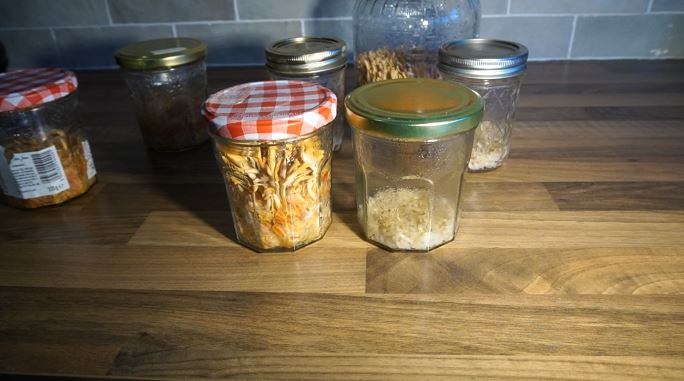
The picture above shows what I believe is the perfect amount of rice for a jar (left is 40g rice, too much, right is 10g rice, perfect).
Growing Parameters for Cordyceps Militaris
Speed – ★★ – Cordyceps Militaris typically takes 6 weeks to produce fruits.
Difficulty – ★★★★ – This fungi requires precise environmental control and sterile technique, however I've found Cordyceps are quite contaminant resistant (It grows on insects so no shock there).
Yield – ★★★★★ – With proper care, Cordyceps can produce a generous amount of fruiting bodies.
Seasonality: Autumn, Winter, Spring.
- Inoculate sterilized brown rice nutrient broth mix with Cordyceps Militaris liquid culture.
- Place the culture in a dark place at temperatures of 70-75°F (21-24°C) for 3 days or until fully colonized
- Remove cordyceps mycelium from dark location and allow it to colonize in natural light or a LED fruiting chamber. Mycelium left in the dark too long will over colonize resulting in “overlay” which is where a thick layer of mycelium covers the substrate which won’t fruit.
- Introduce a light cycle (e.g. 12 -16 hours on, 12 hours off) and slightly reduce temperatures to about 65-70°F (18-21°C).
- Continue with these conditions fruiting bodies develop and mature, typically within 6 weeks.
- Do not allow the fruiting chamber to rise above 20c this is very important, avoid leaving the fruiting chamber (with LED lights) near south facing windows as the heat from the lights and sunlight will create a greenhouse effect raising the temperatures up.
- Indoor cultivation is relatively simple if you can provide consistent temperatures.
- Harvest the fruit once the Cordyceps produce bulbous ends (or reach the top of the jar).
Step-by-Step Guide to Grow Cordyceps.
In this section I will discuss two methods for growing cordyceps mushrooms, using jars is an absolute beginner technique which should be easy for anyone to follow, using containers is slightly more difficult but still relatively easy if you understand some sterile technique.
Both techniques create a similar amount of fruiting body however containers are less work at scale but come with the added risk of contamination.
Requirements
- Fresh Cordyceps Liquid Culture.
- Pressure cooker.
- Jars Or Containers.
- Micropore tape.
- Brown Rice.
- Yeast.
- Light malt extract.
- Dextrose.
- Mealworms (optional).
- Alcohol.
- Face Mask / Gloves.
- Large Syringe.
- Large container for fruiting.
- LEDs for fruiting chamber.
- Magnetic jar stirrer & stir bars.
- Butane torch.
Expand The Cordyceps Liquid Culture.
The first step for growing cordyceps is to take your culture and expand it into 1 litre jar. This will give you enough culture to inoculate lots of jars or containers with a high volume of spawn.
Cordyceps doesn’t expand outward like most other mushrooms, instead it seems to only move around 1 cm in all directions as a result you have to cover your whole substrate with lots of liquid culture.
- Mix 10g LME (light malt extract), 10g dextrose with 1 litre of water.
- Sterilize the liquid culture mixture for 30 minutes at 15 PSI.
- Inoculate this culture with 2cc of cordyceps liquid culture.
- Give the liquid culture a mix every day for 1-2 minutes using a magnetic stirrer.
- Place the liquid culture in incubation for 7-14.
- The liquid culture solution will be complete in around 7 days.
- Use the liquid culture within 14 days of creation.
Please read the following post “how to make LME liquid culture or how to make liquid culture” if you have never done this before, it will give you a more in-depth analysis.
Growing Cordyceps In Jars.
Follow these instructions a few times before experimenting with ingredients and you will grow plenty of cordyceps whilst also understanding some of the nuances of the process.
All the jars used have a gas exchange hole in the top covered in micropore tape.
Create Cordyceps Substrate.
.To prepare the nutrient broth / substrate mixture I do the following:
- Weight out 5g LME, 5g Nutrition Yeast and 5g Dextrose.
- Next mix this mixture with 500ml of water in a blender or with a spoon until the mixture combines.
- Weight out 1.5g of rice per every cm of diameter on the bottom of the jars.
- Add 18ml of broth to each jar containing 10g of rice.
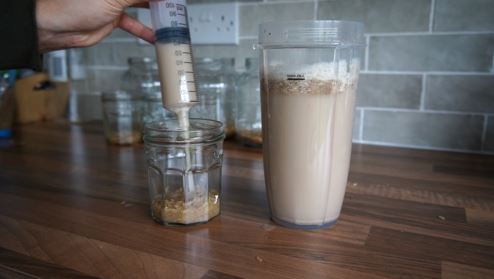
- Put the lids on the jars and then cover them with tin foil.
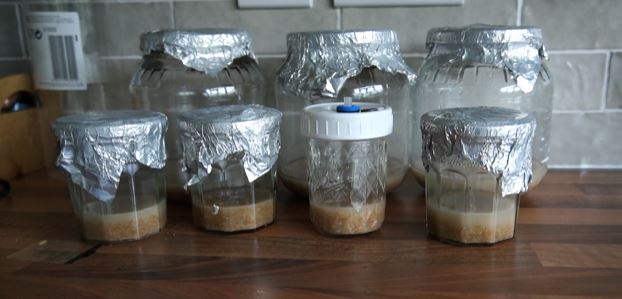
- Sterilize the jars at 15 psi for 40 minutes in a pressure cooker.
- Leave the jars to cool overnight before inoculation.
Inoculate Each Jar.
Next I place all the jars (including the Cordyceps LC jars) into a still air box after first giving them a wipe down with alcohol solution.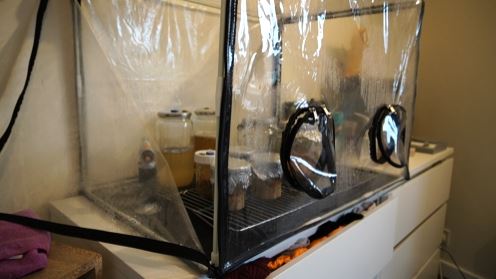
Sterilize a syringe by boiling a pan then drawing up the boiling water and squirting it back out multiple times. Then move this syringe into the still air box aswell, wiping the outside down with alcohol solution,
Flame sterilize the syringe and draw up 5ml of Cordyceps liquid culture solution and inject it into each 10g jar, making sure to cover as much of the substrate as possible. I do this by inoculating in a circular motion across as much substrate as possible.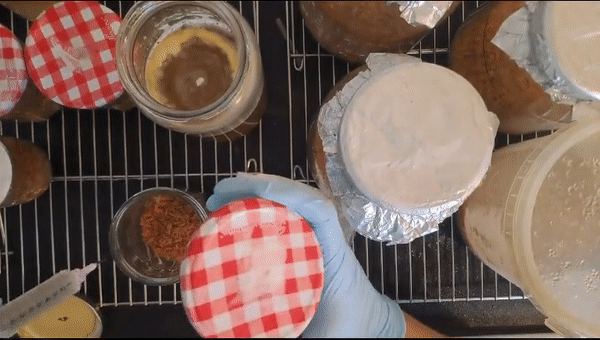
Growing Cordyceps In Containers.
If you want to grow Cordyceps in bins or containers then follow the instructions below.
To prepare the nutrient broth / substrate mixture I do the following:
- Weight out 5g LME, 5g Nutrition Yeast and 5g Dextrose.
- Next mix this mixture with 500ml of water in a blender or with a spoon until the mixture combines.
- Weight out enough rice to fully cover the bottom of your containers with 1 layer of rice.
- Next weight the amount of rice which was required (this will be used to calculate how much broth is needed).
- Pour the rice into a container which can be pressure cooked. I use a small container for holding cereal but even a large jar could work.
- Add the correct amount of nutrient broth to rice in the small container (use the calculator above).
- Sterilize the substrate mixture for 40 minutes at 15psi.
- Allow the pressure cooker to cool down.
Inoculation.
Once the pressure cooker has cooled down, follow these instructions:
- Move the substrate, Cordyceps liquid culture and the fruiting container into a still air box.
- Wipe down the growing container with alcohol.
- Wipe and flame sterilize a spoon.
- Dish the substrate from the sterilized container into your fruiting container and pat down the substrate until it is flat and even.
- Inoculate the substrate with liquid culture until the whole surface of the substrate has been covered.
- Put the lid on the container.
- Repeat for each fruiting container.
- Put containers into incubation conditions.
Incubate the Cordyceps.
Leave the inoculated cordyceps at room temperature under complete darkness for about 3 days. Once the mycelium has become fluffy, move the cordyceps into fruiting conditions.
Do not let your cordyceps over colonize in the dark or you will end up with “overlay” (where the mycelium becomes too thick) and the mushrooms will struggle to fruit.

This is how my Cordyceps look after a couple of days, these jars are ready to be moved into fruiting.
Fruiting Cordyceps.
Move the jars or containers into cooler temperatures between 15c – 21c under LED light conditions to initiate fruiting, this can take up to 6 weeks so be patient.
First the substrate will completely colonize, next the cakes will start staining orange and finally fruits will begin to grow from the cakes.
Below are pictures for comparison:
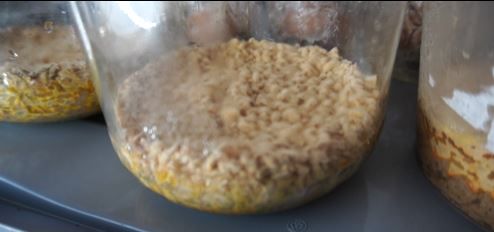
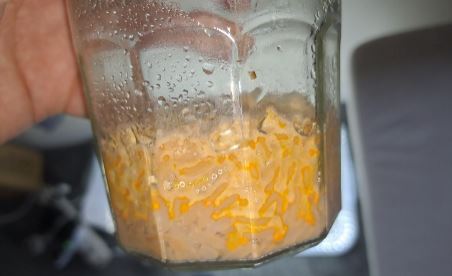
I personally use an old still air box which has been wrapped in LED lighting which has a 16 hour a day light cycle using an automatic controller.
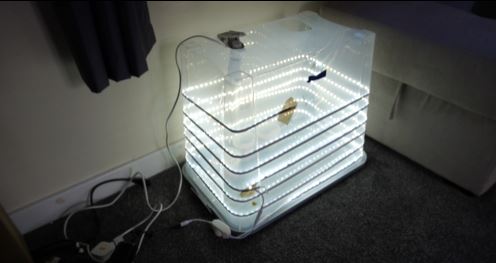
Next I stack my jars and containers inside it and leave it alone, only checking to ensure the temperature does not exceed 21 degrees.
Make sure you absolutely keep this box away from radiators or Windows, if the sun shines onto the box it essentially creates a greenhouse and temperature will sky rocket so consider this before positioning it.
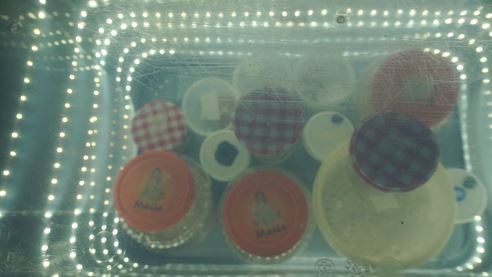
The mushrooms will grow within six weeks and dont need much intervention at all, just leave them alone and remove anything that's contaminated.
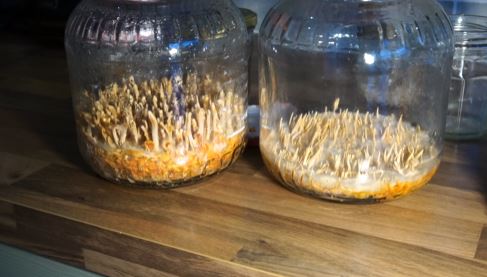
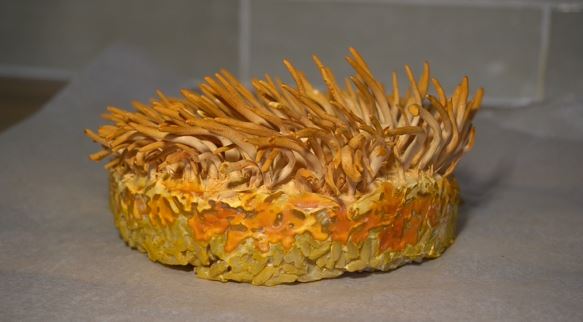





One thought on “Cultivating Cordyceps Militaris – A Complete Guide.”
Very good instructions. I’m afraid I let my first run go for too long at each stage.